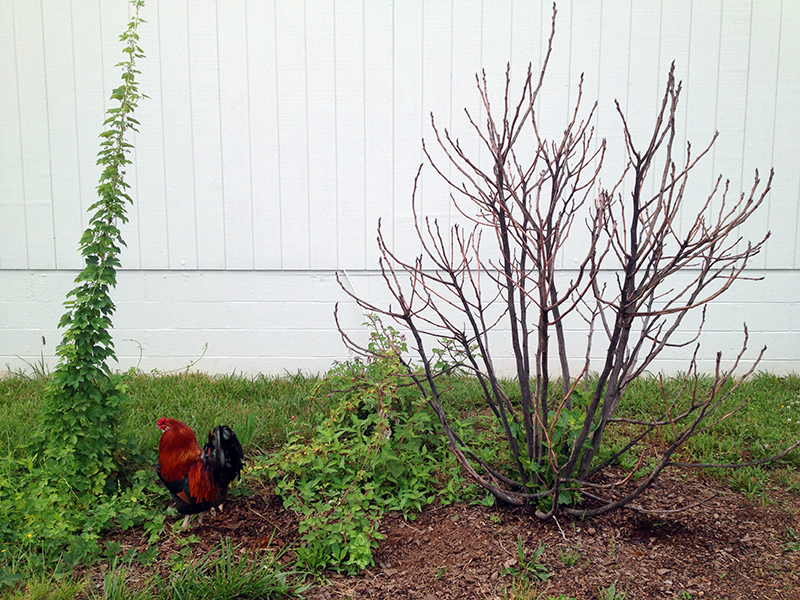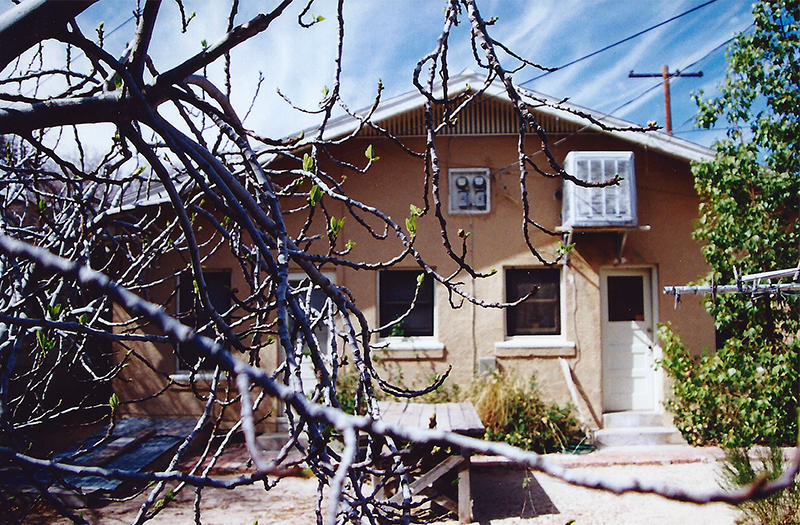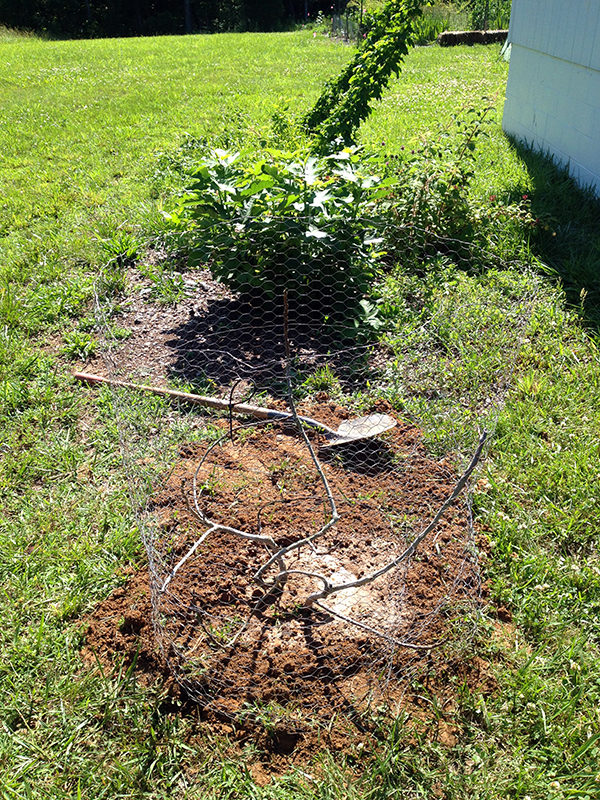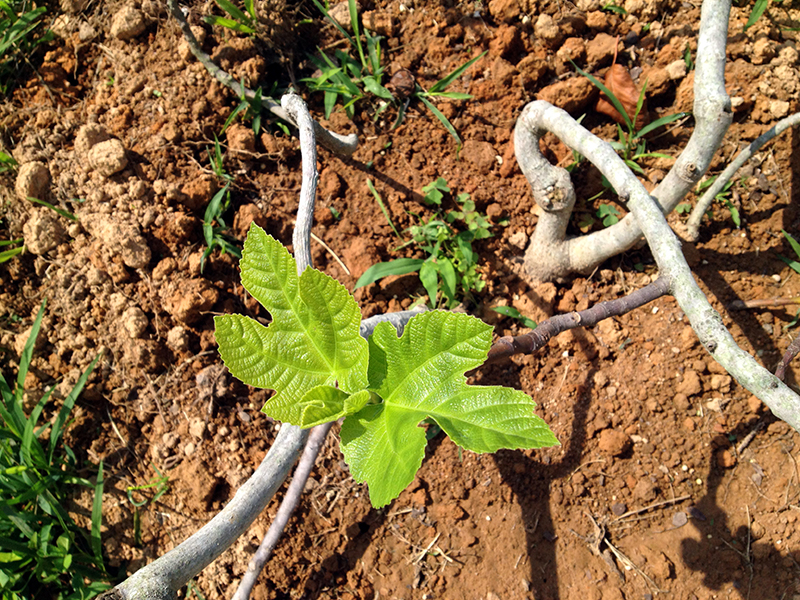All things considered, last winter’s polar vortex left Bonafide Farm relatively unscathed. I lost a few plants, including some huge rosemary bushes, a new lilac, and a handful of perennials. My ‘Pat Austin’ rose died back by half but returned with new canes, only a bit misshapen. But my fig tree was another story entirely.
Figs are considered to be tender trees in this climate, even in non polar vortex winters, and only survive if planted in warm, sheltered locations. Knowing this I planted mine, a cultivar called ‘Celeste,’ on the south side of the big white garage wall, where it would bake in the summer and enjoy wind protection and reflected heat in the winter. 
It seemed to be doing well, and after three or four years in the ground, last year it attained about six feet in height and was really starting to crop. I was pretty happy I got a fig to grow here. This year, however, I waited and waited for signs of life from it. April passed, and May crept on. The bare grey branches showed no sign of budding, and I started to lose hope and began planning to replace my fig.
But then in early June I saw tiny green buds sprouting from the fig’s base. Halleluiah! I held off on cutting back the dead branches until it became clear that the tree was in full rejuvenation mode, coming back from the ground, and all its old wood was dead. Then out came the saw and pruners and I dismantled several years of growth to make way for the new sprouts.
As the heat’s turned on the fig has taken off, lush and thick with growth that’s now about two feet tall. It will probably be another three years until it bears fruit again, but I am just so happy to have not lost the tree that I can wait.
And speaking of waiting, let me tell you a story about a fig that waited fifteen years to find a home at Bonafide Farm.
I went to college in Tucson, Arizona, and when I was either nineteen or twenty I moved into an old stucco duplex south of campus. I was told that the home was built around 1900 by German immigrants who were hired to build the railroad through Tucson. Each German family brought cuttings of their fig trees from back home and planted them in their new country. I had one such fig tree in my backyard, and it took up most of the lot. It was huge, probably 15 feet tall and wider than that, thick with gnarly grey branches that bore copious green figs. Here’s the only photo I could find, which I scanned, looking at the back of the house through the fig branches, which are just leafing out:
Knowing nothing about tree propagation, I took cuttings from this fig and stuck them in coffee cans of soil on my porch. Amazingly, they rooted. I got two small trees growing, which I potted up into successively larger pots…and then proceeded to cart around the country for the next fifteen years. The trees went with me to San Diego, and while I was living in DC they lived at my parents’ house, where my mom made sure they didn’t die. Four years ago the trees came to live here, but I still didn’t plant them in the ground because I was afraid they wouldn’t be able to take the winter and would die. So they stayed in their pots, where I had essentially turned them into bonsai by limiting their growth, and they produced a few pale figs in the summer. Each winter I stored them in the wellhouse.
Well, this spring when I pulled them out they weren’t looking so hot, which I understood as it got cold enough to freeze the pipes in the wellhouse last winter. The figs’ branches were dry and shriveled, and I couldn’t sense a heartbeat from either tree. Still, I stuck them in the sun and watered them, and waited, growing more forlorn as the weeks passed with no signs of life. I was very sad to lose trees that had such history, and mad at myself for not planting them in the ground earlier (which I am learning is a pattern of mine, and one to be changed), even though there’s no guarantee they would have fared better there.
But then last week I looked at one of the trees and saw the palest shade of green on one of the branches. Could it be? Was it still alive?
Wasting no time—this time—I dug a hole right next to my other fig (for botanical companionship and moral support), and planted my Tucson fig. I watered it in well, and put up a chicken wire fence to protect it from the dog. Within three days the green bud burst into a tiny leaf, and other green buds appeared. Now, after just a week in the ground, the fig is leafing out.
And there’s the story of the redemption of the figs, and how new old trees grow at Bonafide Farm.






I really enjoyed reading this post. I live in Brisbane, Australia and we have an enormous old fig tree planted by the original people who owned our house. It’s about 4m tall, and at least that wide, and we get many kilos of fruit each summer.
Hi, Kate!
It’s great to have a reader from Australia–welcome! I would love to have a fig as big as yours–but with the weather here in Virginia it doesn’t look like that will happen. Enjoy your figs!